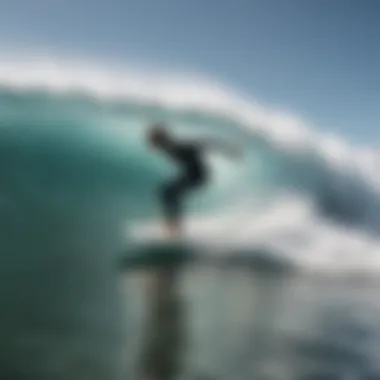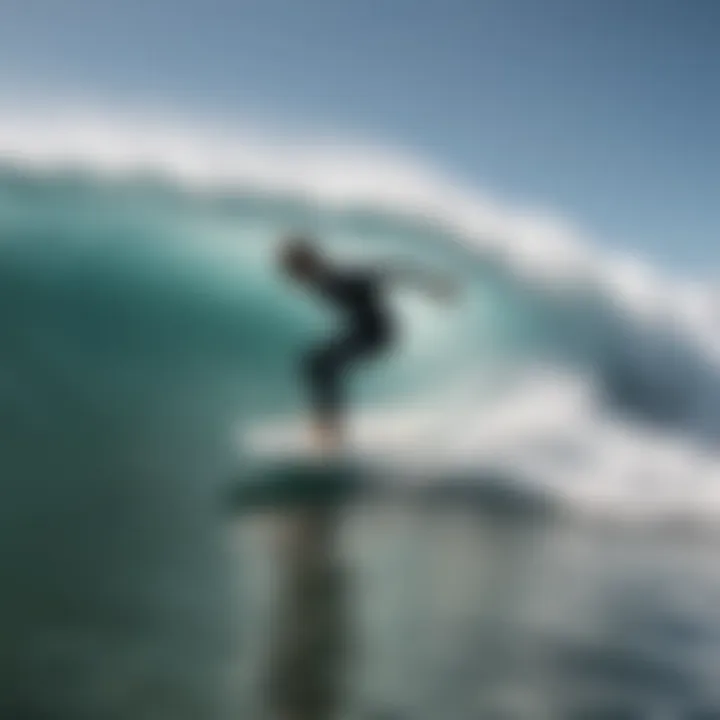Dynamics of Surfboards with Foils: Mechanics & Performance


Intro
Surfboards with foils are starting to create quite a buzz in the surfing community. These boards are not just your typical longboards or shortboards anymore; they come with a unique twist that changes the game entirely. Foils elevate the surfer above the water, allowing them to glide over waves with less resistance. The feeling of flying just above the ocean surface is something every surfer dreams of. But how does it all work?
In this article, we'll peel back the layers and explore the mechanics of these foil surfboards. We’ll dive into the design, performance, and the cultural shifts they are prompting amongst surfers. Whether you're a beginner trying to catch your first wave or a seasoned surfer looking for that edge, understanding these boards is crucial. You'll discover not only the advantages but also the challenges that come when navigating through waves with a foil.
As we delve deeper, we’ll also talk about site environmental implications and how the usage of these boards might reshape the future of surfing. Join me as we ride this wave of innovation together, shredding through knowledge that impacts both the sport and the environment.
Prologue to Surfboards with Foils
As surf culture continues to evolve, surfboards with foils emerge as an innovative addition. This intersection of technology and surfing offers new ways for riders to experience the waves. The introduction of foil technology marks a turning point in how surfers engage with the ocean. By elevating the board above the water, foils reduce drag and enhance glide, which fundamentally changes the dynamics of riding.
The Importance of Foil Surfboards
Foil surfboards provide several significant benefits, making them a compelling topic of discussion for enthusiasts and professionals alike. First and foremost, they allow surfers to harness energy from smaller and weaker waves. Surfers can ride for extended periods without needing a significant swell, transforming everyday water conditions into exciting opportunities for practice and exploration.
Moreover, foil surfboards deliver a unique sensation of flying above the water. This can create an exhilarating experience that traditional surfing may not provide. The shift in balance and control challenges riders to adapt and refine their technique, potentially enhancing their skills in all forms of surfing. However, understanding this technology goes beyond the thrill.
Considerations of Foil Technology
While foil boards offer enticing advantages, they come with their own set of considerations. Riders must be aware of safety measures, as foils can pose risks, especially when it comes to collisions with other surfers. Furthermore, mastering foil surfing requires practice and patience. It is a different beast altogether; the balance and feel can initially unsettle even seasoned surfers.
Engaging in this innovative surfing style opens discussions about ecological impact, social dynamics, and the evolution of surfing culture itself. Surfers must also stay informed about equipment choice, learning curves, and the necessity for proper instruction.
As we dive deeper into the intricacies of foil technology and its role within the surfing community, we will also reflect on the evolution of surfboards that brought us here. By exploring these dimensions, we aim to shape a comprehensive understanding of surfboards with foils.
Understanding the Mechanics of Foils
Understanding the mechanics of foils is crucial to fully grasp how they transform the surfing experience. Foil surfboards enable riders to glide over the water’s surface, minimizing drag and allowing for a completely new level of maneuverability and speed. Grasping these mechanics opens doors to advanced surfing techniques and enhances the thrill of the sport. The ability to ride above the water fosters a unique connection to the ocean. It’s quite unlike traditional surfing, where balance and paddling efficiency are dependent upon direct water contact.
How Foils Work Underwater
Foils function based on principles of hydrodynamics, fundamentally altering how surfers harness wave energy. When a foil moves through the water, the shape and angle of its wings create differing pressures on the top and bottom surfaces. This pressure difference results in lift – akin to how an airplane wing operates in the air. The key is in the angle of attack, which allows the foil to generate lift as water flows smoothly over it. As the speed increases, so does the lift.
Interestingly, foils will typically generate more lift as the board gains speed, which is why these boards excel in catching and riding smaller or less powerful waves. By utilizing the undertow created by waves, surfers find themselves skimming just above the surface, often experiencing a sensation of weightlessness. In this delicate dance with the water, even the slightest adjustments in stance or angle can significantly impact performance.
Foil Lift and Drag Forces
The interplay of lift and drag forces governs the performance of a foil surfboard. Lift is, undoubtedly, the star of this show, providing the elevation needed to keep the board above the water. However, it’s the drag force that can sometimes be the party pooper, resisting forward movement and hindering the ability to maintain smooth motion.
Surfers adeptly manipulate these forces through various techniques:
- Optimal Speed: It’s a balancing act; gaining speed will increase lift but too much speed can result in an unwanted drop in control due to increased drag.
- Adjusting the Angle of Attack: A subtle shift in body weight influences the foil's angle of attack, dynamically altering lift and drag levels.
Inexperience, however, may lead to overpowering either lift or drag forces, resulting in wobbly rides or, worse, wipeouts. Surfers must be attuned to the feedback from their boards, as it guides them in mastering these forces.
Materials and Build of Foils
The materials and construction of foils contribute considerably to their overall performance characteristics. Foils are primarily built from lightweight materials that withstand the last thing you want—failure mid-ride. Here are some common materials:
- Carbon Fiber: Renowned for strength and lightness, carbon fiber foils offer a high performance but can come with a heavy price tag.
- Aluminum: A more economical choice, aluminum foils have decent strength and durability but tend to be heavier than carbon options.
- Plastic: Typically found in beginner models, plastic foils are safer and affordable but might lack the responsiveness of their advanced counterparts.
Aside from the material, the construction process also varies. Some foils may utilize a monocoque design, providing a single structure for maximum strength and reduced weight. Others might feature removable wings, enabling surfers to customize based on conditions or personal preference.
By way of that, choosing the right foil material and design can profoundly impact performance, shape style, and ultimately, surfing enjoyment. Each rider will naturally have different preferences based on their skill level, type of waves they’re riding, and personal expectations.
The mechanics of foils not only allow surfers to perform enhancements—it's about engaging with the wave and oceanic dynamics in a completely fresh manner.
Performance Considerations
In the realm of surfboards equipped with foils, the topic of performance considerations plays a crucial role in understanding how these innovative boards can reshape a surfer's experience on the waves. The dynamics of foil surfing go beyond mere thrill-seeking; they combine technology with skill, ultimately affecting how surfers engage with the ocean. This section unpacks the three main aspects: advantages, challenges, and the necessary adaptations in surfing techniques.
Advantages of Foil Surfing
Foil surfing isn’t just a new trend; it’s an evolution in the way we interact with water.
- Increased Speed and Efficiency: One of the standout features of foil boards is their ability to glide smoothly over water. When the foil is submerged, it reduces drag, allowing surfers to achieve higher speeds with less effort. Surfers often find themselves propelled forward even in smaller waves, giving them ample opportunities to explore various surf spots.
- Access to New Conditions: Imagine riding waves that would usually be deemed unsurfable. With foils, surfers can glide over choppy waters, mushy waves, and even the flat sections between sets. This opens doors to surfing in varied conditions, enhancing the surfer's flexibility and adaptability.
- Less Physical Fatigue: Since foil surfing requires less paddle power to start moving, users report less fatigue after sessions. This aspect allows surfers to stay longer in the water, focusing on form and technique rather than endurance.
"In foil surfing, every ride becomes an art, transforming mundane conditions into a dance with the ocean."


Challenges Faced by Surfers
Despite its benefits, foil surfing isn’t all sunshine and rainbows. There are bumps along the way that surfers must navigate to fully reap the rewards of this technique.
- Steeper Learning Curve: Transitioning from traditional surfing to foil surfing can be jarring. Balancing on a foil requires distinct body awareness and coordination. Many newbies feel frustrated initially as they learn to master the art of balance and foot positioning. Falling off is part of the game, and patience is key.
- Risk of Injury: Foils have sharp edges, which can present dangers during collisions or fall-outs. Surfers must keep this in mind, wearing appropriate gear and maintaining awareness of their surroundings to minimize the risk of injury.
- Equipment Issues: Choosing the right equipment can be challenging. With numerous models available, each with different sizes and shapes of foils, surfers often find themselves confused. Getting the right fit can significantly impact overall performance, making it crucial to adapt and adjust.
Adaptation in Surfing Techniques
Mastering foil surfing isn’t simply about jumping on a board and gliding; it’s crucial to adapt existing techniques to harness the full potential of foils.
- Paddle Technique: Surfers need to tweak their paddling methods. A crisp, efficient stroke is necessary for foiling to catch waves effectively. Overexerting paddles won't yield the same results as with regular boards.
- Takeoff Adjustments: The takeoff paragraph demands a different approach. Riders must focus on timing their weight shifts and keeping their speed steady as they rise above the water's surface. Delaying or rushing this process can lead to unstable rides.
- Maneuver Transitioning: Turning and navigating becomes a novel experience. Surfers must learn to rely on their body movements more than on their arms or shoulders. Practicing smooth transitions can drastically improve performance.
By being aware of these performance considerations, surfers can better appreciate the challenges and advantages of foil surfing. The balance between understanding these dynamics and mastering the techniques plays a pivotal role in the journey of every aspiring foil rider.
Types of Foil Surfboards
Understanding the various types of foil surfboards is crucial for anyone diving into this new wave of surfing innovation. Each board caters to different riding styles and experiences, making it essential to choose the right one to enhance your performance and enjoyment on the water. In this section, we’ll discuss three main categories: all-around foil boards, dedicated foil surfboards, and hybrid boards, breaking down their characteristics and unique advantages.
All-Around Foil Boards
All-around foil boards typically strike a balance between versatility and performance. They are designed to cater to a variety of surfing conditions, allowing riders to experience everything from small, rolling waves to bigger swells. The shape of these boards often has a wider tail and a fuller nose, making paddling easier and providing stability.
Benefits of All-Around Foil Boards:
- Versatility: Can be used for multiple surf conditions, making them a great choice for beginners or those who enjoy different types of surfing.
- Stability: With their larger surface area, these boards offer more stability, aiding in quicker takeoffs and control.
- Ease of Use: Ideal for learning foil techniques without the steep learning curve associated with specialized boards.
An all-around foil board is an investment for those looking to enhance their skills with minimal risk. As they say, it’s a jack of all trades but a master of none, yet it can be the perfect companion for many a surf session.
Dedicated Foil Surfboards
Dedicated foil surfboards are built specifically for foil surfing. They feature a refined design that enhances performance in wave riding. These boards typically have a narrower outline and less volume than their all-around counterparts, allowing for sharper turns and quicker response times. However, they can be less forgiving, requiring a higher skill level to master.
Considerations for Dedicated Foil Surfboards:
- Performance: These boards excel in specific surf conditions, making them tireless companions for experienced surfers who can maximize their potential.
- Maneuverability: Their design allows for quick turns and high-speed rides, which can elevate the surfing experience significantly.
- Tailored Experience: Suited for those who’ve mastered the basics of foil surfing and are looking to progress with their skills in more challenging conditions.
While they pack a punch in terms of performance, it’s important to approach these boards with respect, understanding that they require practice and finesse to handle correctly.
Hybrid Boards and Their Utility
Hybrid foil surfboards merge the best of both worlds, incorporating features from both all-around and dedicated boards. These boards allow for not just foil surfing, but can also perform well in traditional paddling. Emphasizing flexibility, hybrids offer an ideal solution for surfers who want to dabble in different surf styles without needing multiple boards.
Utility of Hybrid Boards:
- Flexibility: Perfect for transitioning between different surf techniques, accommodating various skill levels and preferences.
- Adaptability: They can service both flat-water and wave conditions, making hybrids a practical choice for surfers who like to try it all.
- Cost-Efficiency: By eliminating the need for several boards, hybrid boards offer excellent value, especially for those just stepping into the realm of foiling.
In the ever-evolving world of foil surfing, these hybrid boards stand tall as versatile tools designed for the adventurous spirit.
"The right foil surfboard can make all the difference: it’s not just about riding the wave, but mastering the ride."
Choosing the Right Foil
Choosing the right foil is an essential aspect of mastering foil surfing, and it can often make the difference between an enjoyable ride and a frustrating struggle. The dynamics of foil surfboards are heavily influenced by the selection of the foil itself, with various shapes, sizes, and materials available on the market. Picking the appropriate one not only enhances your performance but also aligns with your skill level and surf style. When your foil complements your surfing abilities, the experience transforms into something holistic and exhilarating.
Understanding Size and Shape
The size and shape of a foil significantly dictate how it interacts with water, generating lift or drag. Generally speaking, larger foils create more lift but require more speed to get up. As such, a larger foil may be beneficial for beginners who need that extra buoyance. Conversely, experienced surfers may prefer smaller foils for agility and speed, allowing for nuanced movements and tighter turns.
There are oversized front wings, which help in generating lift quickly and are particularly good for wave catching. In contrast, their smaller counterparts allow quicker response and are often suited for choppy waters. Understanding these nuances assures surfers make an informed decision, taking into account their personal preferences and local conditions.
Matching Foils with Surf Style
Not all foils sit well with every surf style. Consideration of your surfing approach should guide your foil choice.
- High-Performance Surfers: They may lean towards specialized, smaller lift-generating foils that allow for extreme maneuverability.
- Cruiser Surfers: Those who enjoy taking it easy might find shorter, wider foils to suit their slower, more relaxed surfing techniques.
- Freestyle Riders: If you like to catch some air and perform tricks, you might benefit from foils designed for jumping with a stable design that helps maintain altitude.
Ultimately, the aim is to complement your techniques with the right foil so that you can express your surfing style authentically. The right fit can dramatically alter how fluid and natural the experience feels on the water.
Guide to Brands and Models
When it comes to brands and models, the market's breadth is stunning. Here are some noteworthy ones that stand out based on their performance and innovation:


- Armstrong Foils: Known for their strong materials and cutting-edge designs, they offer a range of sizes that accommodate different abilities.
- Naish Foils: Praised for their versatility, Naish provides options for both newbie and seasoned surfers, making it easier to switch up styles without compromising quality.
- Lift Foils: They focus on user-friendly designs that facilitate easier takeoffs, especially for beginners.
Researching each brand's offerings will lend insight into which foil may be a good fit for your individual needs and budget considerations. Always read reviews, and don’t hesitate to consult with experienced surfers or retailers who can share their expertise.
“The right foil not only enhances your performance but also aligns with your skill level and surf style.”
As you embark on your journey in foil surfing, remember that choosing the perfect foil should be a calculated decision. Understand your personal requirements, adapt to your surfing style, and don't shy away from seeking advice from the community for those invaluable insights.
Safety Considerations when Surfing with Foils
Surfing with foils presents an exhilarating experience, yet it comes with its own set of challenges and risks. It's crucial for surfers to grasp the safety considerations associated with foil surfing, which play a pivotal role in ensuring both the physical well-being of the individual and the enjoyment of the sport. Being aware of potential dangers can lead to better decision-making on the water and promote a culture of safety within the surfing community. Here are some key aspects to consider.
Understanding Risks and Precautions
Foil surfing, unlike traditional surfing, introduces a few unique hazards. The presence of the foil adds a different dynamic, mainly due to its elevated position above the water. This elevation can allow for higher speeds and greater lifts, but it also increases potential risks. It is important to be aware of:
- Collision Risks: The foil itself can pose a threat; if a surfer loses balance or control, the foil can accidentally strike them or others in the water. Therefore, maintaining control at all times is non-negotiable.
- Drowning Concerns: In case of a wipeout, a quick dive under the surface is necessary to avoid the foil’s path. It can be easy to lose orientation under the water, heightening the risk of injury.
- Environmental Hazards: Whether it’s a rocky shoreline or shallow reefs, understanding your environment can prevent accidents. Before hitting the water, assess any potential hazards in the surfing area.
"Risk management is not just about avoiding danger but also about understanding how to navigate it safely."
Equipment Safety Checks
Before heading out, conducting a thorough equipment safety check is as vital as warming up. Ensuring that your gear is in top shape not only maximizes performance but also minimizes risks. Here are several checks to keep in mind:
- Inspect the Foil: Look for any signs of damage or wear. Ensure that the wings, mast, and fuselage are secure and free from cracks.
- Board Stability: Make sure that the board’s attachment points for the foil are intact and that the foil is securely mounted to the board. Any looseness can lead to catastrophic failure during a ride.
- Leash Evaluation: Confirm that your leash is not frayed; a strong leash is crucial for keeping your gear close after a wipeout.
- Personal Flotation Device: Depending on the conditions, wearing a flotation device may be advisable, as it can provide crucial support in emergency situations.
Best Practices for Beginners
For those just starting out in the world of foil surfing, safety is paramount. Here are some best practices to implement:
- Start in Safe Conditions: Choose a day with gentle waves and minimal wind, especially if you're still learning the ropes. Crowded beaches can also be overwhelming; seek out less populated areas.
- Invest in Lessons: Consider taking lessons from an experienced foil surfing instructor. Learning the ropes from a seasoned pro can significantly reduce risks and improve techniques.
- Practice Falling: It may sound silly, but practicing controlled falls can prepare you for real situations, making it easier to react instinctively.
- Buddy System: Surfing with a partner not only enhances the fun but also provides an extra layer of safety. A friend can keep an eye out for dangers while you focus on your technique.
Being aware of safety aspects when using foil surfboards isn't merely a suggestion; it is a necessity. By taking the time to understand risks, properly check equipment, and adhere to best practices, surfers can enjoy the thrill of riding the waves with confidence and less anxiety.
Foil Surfing Techniques
Understanding foil surfing techniques is key to mastering this innovative way of riding waves. Unlike traditional surfing, foil surfing requires a different set of skills and awareness of the board's mechanics. Surfers must adapt their techniques to harness the full potential of the foil, which enhances performance through lift and gliding.
Paddling with a Foil Board
Paddling with a foil board is a unique experience. It feels notably different from paddling a regular surfboard due to the increase in buoyancy. That’s because the foil provides significant lift once it picks up speed. Surfers need to position themselves correctly, often further back on the board than usual. This adjustment helps avoid the board nosediving, which can be a common pitfall.
A few tips for effective paddling include:
- Body position: Keeping your hips up and maintaining a streamlined shape allows for better flow through the water.
- Paddle strokes: Short and quick strokes work better than deep pulls, helping to maintain stability.
- Breathing: Remember to breathe normally, as the excitement can lead to shallow breaths, impacting endurance.
"To paddle well is to dance with the water; adapt your movements and the rhythm will come to you."
Takeoff Strategies
Taking off on a foil board is another crucial aspect of mastering the sport. The initial wave-catching moment can be a bit daunting. Unlike traditional surfing, where you rely on the wave’s push, in foil surfing, the technique shifts to a more controlled rise. Surfers must time their paddling and wave selection meticulously.
- Wave selection: Look for waves that offer a clean face and a gradual incline. Avoid steep or choppy waves at first, as they can create instability.
- Timing: As the wave approaches, begin your paddle early. Timing is everything; too late means missing the lift.
- Pop-up technique: Once you feel the wave moving beneath you, pop up quickly. A quick movement minimizes the chance of the board subsequentially dropping back down into the water. Your feet should be positioned towards the back of the board to maintain balance.
Turning and Maneuvering
When it comes to turning and maneuvering on a foil board, it’s almost like learning to drive a sports car. It requires finesse and a deep understanding of the board's dynamics under your feet. Most surfers will quickly discover that the foil's lift allows for sharper turns than traditional boards allow.
- Initiate turns early: As a wave approaches its peak, initiate your turn ahead of time. This will ensure that you’re not caught off guard and helps maintain speed.
- Weight distribution: Leaning into the turn with your weight on your back foot allows for quicker, tighter arcs. Moving your weight too far forward might cause the foil to breach.
- Use your arms: Your arms can help with balance during maneuvers. By slightly extending or pulling back your arms, you can adjust your center of gravity effectively.
In essence, the art of turning on a foil board is about finesse and understanding that each movement affects your lift and direction. Mastery over these techniques ensures that any surfer can find joy in this thrilling adaptation of traditional surfing.
Environmental Impact of Foil Surfing
The integration of foils into surfboards represents a thrilling advancement in aquatic sports, but it also ushers in important discussions about sustainability and environmental considerations. In the wake of rising awareness concerning climate change and marine health, it’s crucial to understand how foil surfing, a relatively new trend in the surfing community, can affect our oceans and the environments surrounding them. This section aims to highlight various elements tied to the ecological repercussions of foil surfing, exploring production, impact on marine ecosystems, and responsible practices.
Sustainability in Surfboard Manufacturing
The manufacturing process of surfboards with foils is becoming increasingly important in the context of environmental stewardship. Traditional surfboards often use materials that are not eco-friendly, such as polyurethane and polyester resins, which can take centuries to decompose. In contrast, newer technologies are being employed to craft foils and surfboards from more sustainable materials.


- Epoxy Resins: Known for being less toxic and more environmentally friendly, epoxy is gradually replacing standard polyester resins.
- Biodegradable options: Some manufacturers are venturing into using bio-based resins, a promising alternative that minimizes toxic waste.
- Recycling initiatives: Leading brands are embracing programs that allow surfers to recycle old boards, putting less strain on landfills.
By prioritizing sustainable practices in surfboard manufacturing, the foil surfing community can substantially reduce its carbon footprint. This shift not only appeals to eco-conscious surfers but also sets a precedent for the entire outdoor sports industry.
Effects on Marine Ecosystems
Foil surfing has made waves in the surf community, but its potential impact on marine ecosystems cannot be overlooked. Surfers, by their very nature, are often explorers of diverse environments. Knowing how surf practices influence marine life is vital for maintaining harmony in these ecosystems.
One of the primary concerns is the disturbance of marine habitats. While foil surfing usually involves traversing above the water's surface, the foils can still affect below.
- Disruption to Wildlife: The swift movements of foil boards might scare away fish or disrupt nesting areas
- Maintenance of Aquatic Flora: Studies indicate that modified surf conditions can alter seaweed habitats, which are essential for marine biodiversity.
"Understanding the relationship between foil surfing and marine ecosystems ensures that surfers can operate in harmony with nature."
Taking these factors into consideration can help surfers act as guardians of the environments they cherish.
Promoting Responsible Surfing Practices
As awareness of environmental issues grows, the responsibility falls on surfers to adopt and promote responsible practices. Awareness leads to action, and there are several strategies surfers can implement to minimize their environmental impact:
- Educate Yourself: Knowledge of local ecosystems can lead to more respectful practices while surfing.
- Participate in Cleanups: Engaging in beach cleanups is a simple yet effective way to contribute to the health of the ocean.
- Choose Eco-Friendly Brands: Opt for surfboards and equipment made by companies that prioritize sustainability.
- Share Knowledge: Encourage fellow surfers to adopt environmentally friendly practices, spreading the word through forums or social media platforms like Reddit or Facebook.
In essence, being a part of the foil surfing community doesn’t just mean riding the waves; it includes championing sustainability and protecting the beautiful environments where we choose to surf. Embracing these principles ensures that foil surfing can thrive as a sport, while simultaneously safeguarding our invaluable natural resources.
A Community Hub for Foil Surfing Enthusiasts
When it comes to the evolution of foil surfing, having a community will surely reel in positive changes. A community hub for foil surfing enthusiasts is like a lighthouse guiding lost surfers through choppy waters. It provides a space for information sharing, skills development, and networking among like-minded individuals passionate about this dynamic sport. This becomes increasingly essential considering how rapidly foil technology is evolving, and the importance of staying updated with techniques, gear, and safety measures.
A community hub not only fosters relationships but also ignites collaborative learning that enhances the overall surfing experience. Whether a novice trying to find their footing or a seasoned expert aspiring to master advanced maneuvers, exchanging tips, tricks, and personal experiences with others enriches the surfing journey.
"Coming together is a beginning; keeping together is progress; working together is success."
By engaging with fellow surfers, individuals can tap into a wealth of knowledge that can enhance performance, address issues specific to foil surfing, and break down barriers that may otherwise hinder learning.
Connecting with Other Surfers
When surfers connect, magic happens. Whether through local beach meet-ups or global online forums, meeting other enthusiasts cultivates a vibrant and supportive environment. Many surfers often share insights on the best beaches for foil surfing, local conditions, and even favorite gear. Sharing tips on new techniques or the latest trends, these connections can motivate surfers to try new things they may not have considered before.
- Local Gatherings: Events organized at the beach serve as great opportunities for camaraderie and skill exchange, allowing surfers to engage in joint sessions, trials, and feedback trials.
- Networking through Social Media: Platforms like Facebook provide groups dedicated to foil enthusiasts, allowing members to share experiences, organize meet-ups, and provide recommendations for equipment.
Events and Competitions
Events and competitions add an exhilarating spark to the foil surfing world. These gatherings not only encourage friendly rivalry, but they also foster a sense of community among participants. Events can range from casual meet-ups to organized competitions, showcasing the skill, creativity, and unique style that foil surfing brings.
- Local Competitions: Local foiling contests can draw in surfers from diverse backgrounds, encouraging participation from different skill levels, which, in turn, helps foster growth.
- International Events: Global competitions, like the World Cup Series, offer a platform for surfers to broadcast their skills on an international stage, allowing them to gain insights on techniques and experiences from skilled foilers worldwide. Such high-stakes events often lead to valuable interactions among top athletes.
Online Resources and Forums
The digital age has made accessing knowledge easier than ever before. Online resources and forums dedicated to foil surfing are indispensable. They serve as vast reservoirs of information, providing surfers access to tutorials, articles, and discussions on techniques, gear choices, and foiling principles.
Some notable online platforms include:
- Reddit: Subreddits focused on surfing offer a lively forum for enthusiasts to discuss everything from equipment to favorite surf spots.
- Special Interest Websites: Some websites are completely dedicated to foiling, providing reviews, tips, and interviews with professional surfers who contribute their expertise.
- Instructional Videos: YouTube channels often feature renowned surfers sharing their best practices, helping users visualize techniques that can be implemented on the water.
Future of Foil Surfing
The potential of foil surfing extends far beyond the present, with advancements on the horizon that promise to redefine both the technology used and the culture surrounding the sport. Understanding the future trajectory of this innovative form of surfing is essential for all involved—from casual enthusiasts to seasoned experts. Key points to consider include the continuous integration of new technologies, anticipated shifts in surf culture, and the prospective contributions to the broader surfing community.
Innovative Technologies on the Horizon
As the surfing industry evolves, so too do the designs and functionalities of surfboards with foils. Several cutting-edge technologies are set to emerge, enhancing performance and accessibility. One notable development is the rise of smart foils, which integrate sensors to provide real-time performance feedback. This innovation allows surfers to fine-tune their technique, maximizing lift and stability on the water.
Furthermore, lightweight composite materials are being experimented with, which improve buoyancy without compromising durability. Manufacturers, such as Naish and Slingshot, are already testing these materials to create boards that are not just easier to manage but also more efficient through the water's surface.
"Technology is just the starting point; it’s how we use it that will push the limits of what foil surfing can achieve."
Predicted Trends in Surf Culture
With the rise of foil surfing, culture is bound to transform in intriguing ways. One significant trend is the growing popularity of communal surfing experiences, where groups utilize foil boards for synchronized surfing sessions, creating a spectacle of coordinated movement on water. These gatherings not only foster camaraderie among surfers but also attract onlookers, thereby increasing public interest in foil surfing.
Moreover, increased environmental awareness is likely to influence the types of events and competitions that are organized. Surf culture often embraces sustainability, and this may lead to competitions where environmental responsibility becomes a part of the judging criteria. Surfers may be seen promoting eco-friendly practices, no longer just as a lifestyle choice but as a badge of honor, enhancing the community's connection to nature.
Potential Contributions to the Surfing Community
The future of foil surfing also presents promising contributions to the larger surfing community. Technological advancements can lead to accessibility improvements, making it easier for beginners to experience this exciting discipline. For instance, training programs utilizing virtual reality could emerge, allowing newcomers to hone their skills before hitting the water.
Additionally, as the popularity of foiling grows, surf schools may incorporate foil surfing into their curriculums, creating new job opportunities for instructors. This shift not only benefits individual surfers but also stimulates local economies reliant on surfing tourism. As foil surfing gains traction, expect to see innovative programs aimed at youth engagement, encouraging the next generation to embrace this unique water sport.















